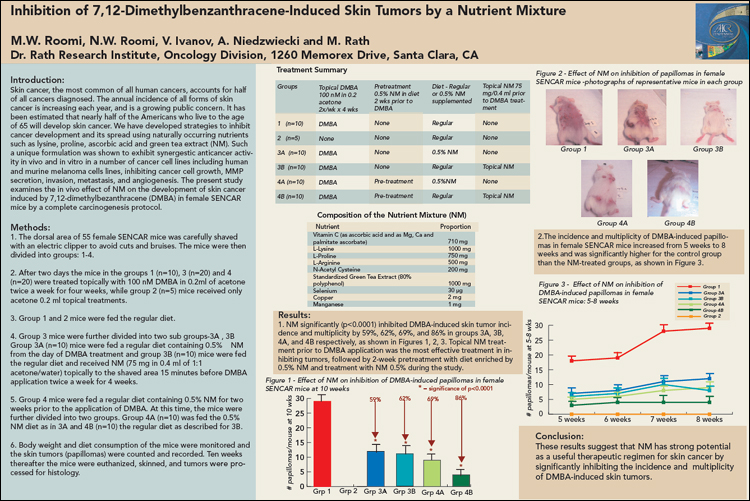M.W. Roomi, N.W. Roomi, V. Ivanov, A. Niedzwiecki and M. Rath
Dr. Rath Research Institute, Oncology Division, 1260 Memorex Drive, Santa Clara, CA
Presented at:
98th Annual Meeting of the AACR, Los Angeles, CA, April 14-18, 2007
Published in:
Proceedings of the 98th Annual Meeting of the AACR, Abstract #2634, p 231
Abstract
Introduction:
Skin cancer, the most common of all human cancers, accounts for half of all cancers diagnosed. The annual incidence of all forms of skin cancer is increasing each year, and is a growing public concern. It has been estimated that nearly half of the Americans who live to the age of 65 will develop skin cancer. We have developed strategies to inhibit cancer development and its spread using naturally occurring nutrients such as lysine, proline, ascorbic acid and green tea extract (NM). Such a unique formulation was shown to exhibit synergistic anticancer activity in vivo and in vitro in a number of cancer cell lines including human and murine melanoma cells lines, inhibiting cancer cell growth, MMP secretion, invasion, metastasis, and angiogenesis. The present study examines the in vivo effect of NM on the development of skin cancer induced by 7,12-dimethylbezanthracene (DMBA) in female SENCAR mice by a complete carcinogenesis protocol.
Methods:
The dorsal area of 55 female SENCAR mice was carefully shaved with an electric clipper to avoid cuts and bruises. The mice were then divided into groups: 1-4. After two days the mice in the groups 1 (n=10), 3 (n=20) and 4 (n=20) were treated topically with 100 nM DMBA in 0.2ml of acetone twice a week for four weeks. Group 1 mice were fed the regular diet. Group 2 (n=5) mice received only acetone 0.2 ml twice for four weeks and fed a regular diet. Group 3 mice were further divided into two sub groups; 3A and 3B. Group 3A (n=10) mice were fed a regular diet containing 0.5% NM from the day of DMBA treatment and group 3B (n=10) mice were fed the regular diet and received NM (75 mg in 0.4 ml of 1:1 acetone/water) topically to the shaved area 15 minutes before DMBA application twice a week for 4 weeks. Group 4 mice were fed a regular diet containing 0.5% NM for two weeks prior to the application of DMBA. At this time, the mice were further divided into two groups. Group 4A (n=10) was fed the 0.5% NM diet as in 3A and 4B (n=10) the regular diet as described for 3B. Body weight and diet consumption of the mice were monitored and the skin tumors (papillomas) were counted and recorded. Ten weeks thereafter the mice were euthanized, skinned, and tumors were processed for histology.
Results:
NM inhibited DMBA induced skin tumor incidence and multiplicity by 59%, 62%, 69%, 86% in groups 3A, 3B, 4A, 4B respectively.
Conclusion:
These results suggest that NM has strong potential as a useful therapeutic regimen for skin cancer by significantly inhibiting the number of papillomas and the incidence and tumor multiplicity of DMBA induced skin tumors.
Comment
The annual incidence of skin cancer, the most common of all human cancers, is increasing each year. Nearly half of Americans who live to the age of 65 will develop skin cancer. We examined the effect of a unique nutrient mixture (NM) that contains lysine, proline, ascorbic acid and green tea extract on the development of skin cancer induced by topical application of 7,12-dimethylbezanthracene (DMBA) in female SENCAR mice. Groups of mice were treated with NM by diet and or topically or with saline. NM significantly inhibited DMBA-induced skin tumors. Topical NM treatment prior to DMBA application was the most effective treatment (reducing the incidence of skin tumors by 86%), followed by 2-week pretreatment with a diet enriched with NM (69% reduction in tumors) and treatment with dietary NM during the study (59% reduction in tumors). These results are significant as they indicate that NM has strong potential as a therapeutic regimen for prevention and treatment of skin cancer.
